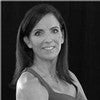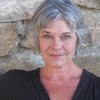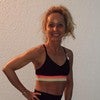Description
About This Video
Transcript
Read Full Transcript
Ah, hi. We're going to do a little postural assessment here and we're going to keep it simple. Sort of non technical, just looking at, uh, Joseph Paul Pilati. He's looked at the, the, the body, like a building. Architecturally spine is your plum line, shoulder girdle, rib cage, pelvis in a perfect world, sitting one on top of the other legs reaching right down under you and a that spine reaching in two directions, top of the head, reaching towards the ceiling, tail, reaching toward the floor. So always working on that alignment. Leslie's here and she's gonna let me, uh, assess her, which is no fun sometimes when you're standing in front of the mirror and see how crooked you are. But we all are. And our beloved Gill Hedley, he says, you have to find balance without symmetry. And so that's what we're after. I do believe that was him. Uh, that's what we're after all the time. And that's what we're after in Peloton is, and every step we take in life is, uh, we're halfway into a fall. So having that postural awareness and, uh, integrity is, is what we're after in [inaudible].
And I'm a good thing to have in life, especially as God willing, we grow older. Uh, we need to know that even more. So we're going to look at Leslie. Leslie as already told me that she has a bad knee and uh, and that means different things to different people. Um, she's got some arthritis in there so it doesn't extend all the way. We can see that she's tiny bit knock kneed, uh, hyperextends on that, uh, left leg. And she told me that she rolls this shoulder forward, uh, and whole end up. And uh, so we're going to look at some of the things that she's already given me in terms of what she knows about herself. She's been working with Ken Gilbert for a long time, so she has a good sense of her body, but we all need to be given the tools to, to see for ourselves. So this is for people who want to, I recommend you get yourself in front of a mirror. And as we go through this, you look at yourself and as I was telling Leslie, our nature is to fix.
You see yourself all on one, like, oh, I'm going to fix it. But that isn't a fixed, that's a superficial action. So we're going to try to be quiet when we find something that's going on. I can feel my right quad just gripping as we speak. Um, but we're going to try to be, uh, quiet as we observe things and then fix them from that center line as opposed to the periphery. Okay? We're going to turn and have you face the mirror and, uh, and those of you watching get in front of your mirror.
And even though I am talking about Leslie's posture, uh, like we, uh, learn in class in dance all the time, every correction, almost every correction is gonna apply to you. So take whatever corrections I'm giving her. If it doesn't apply, let it go. Something will. But you're, you're basically gonna look at yourself, not criticism critically, but critically in terms of your geometry, your vertical lines, your horizontal lines, legs, arms, spine, vertical, collarbones, shoulder girdle, rib cage, pelvis, knees, ankles are your horizontal. So you're going to look at yourself in that sort of context. So we've already noted that Leslie, on her left side, she hyperextends the knee and on her right side, she doesn't have full mobility on that leg.
But we're going to start at the feet. Uh, the goal is to stand with the weight between the big toe and the first toe. Uh, uh, I forget what teacher of mine said that the foot is like an outrigger canoe. The arch is like the canoe. The outside edge is like that little balance bar outside. So you want the weight over big toe, first toe, and many of us extend.
So notice if you're locking your knees and pushing back because a whole number of things happen if you lock your knees that go right up to the top of your head. So you want a nice soft, easy knee and you want your weight over center the feet. Now we're going up and Leslie, if you look in the mirror, and we did notice that Leslie tends to stand with our feet right close together if left to her own devices. So we've brought her apart a little bit and I would almost air because you got tiny bit of a knock knee to uh, or the thighs come in. So you want to have some space there. You don't want to compress your hips in if you can.
And our pants and this at home have a look. Your seam, if you're heavy on one side, that seam gets pulled. So your clothing can tell you a lot. Your shoulder, one strap always falls down. Those kinds of things will tell you something about how you're standing. Women always carry a purse on one side, you're going to notice that shoulder tends to rise.
So you've got a nice hook to hang your bag on and those things a refer all the way up your spine. So we can't fix everything. But in being aware and having the information, you're more likely to, uh, have a chance of making some sort of change. Then, uh, merrily going upon your way, all sideways. So, um, I want you to notice, and I have big thighs and so I can see where one five pushes more into the, in the other thigh than the one. How's that for a good sentence? You want to look at the relationship of one leg to the other and you can feel that because of the immobility in that right leg, it sort of pushes into the left leg. Can you feel that? [inaudible] and that for you folks at home notice and the for you to Leslie, notice where your weight is. Is it more on your right leg or your left leg? Don't fix anything. Just observe. Once you notice, and we already determined your weight is on your left leg and you use your right leg, sort of like a kickstand, you want to take a little weight in that right leg.
If you carry all your weight on your left, take a moment, take a little weight into the opposite leg and then try to find even weight on both legs. Leslie was telling me that she can't extend her right leg all the way and she tries to push her knee back. So I've asked her, sometimes you can't get there by going straight to where the issue is. I've asked her rather than trying to push the knee back to try to lift up off of that leg and low and behold the leg lengthens a little bit more. You can't get more mobility out of that knee because it is what it is. But, uh, the tendency is to surround that limitation with all sorts of superfluous information or energy. So by lifting up out of that leg, it takes more weight, I hope you can feel. And if it doesn't manufacture that, put a little weight.
I use the pubic bone as the center of the world in terms of structural alignment. The, uh, northern hemisphere and the southern hemisphere are supported by the pelvis. So going to that pubic bone, you're going to try to find, and you're going to just look in the mirror because you'll see as you, uh, take the weight up off that right leg and put a little more weight into it. You made a little shift to the right. Could you feel that? Yeah. Just by being there in that moment and trying to feel, not trying to make a big shift, but a subtle little shift. Beautifully done. Uh, of course in [inaudible] we're always trying to support with the abdominal muscles.
So I want you to think of lifting your pelvis up off your legs. Just, it's a small internal, there you go. Yeah. So you've taken the weight of your torso up off your legs. You're assuming the responsibility of your torso there rather than sitting heavy on the legs. So Leslie mentioned that this shoulder, Rosa, we're working our way up from the feet, whereas the weight, the feet, where are the knees going? If you a fear at home and have some shorts on, look at your knee caps, look at, you know, one may be rotated inward. Again, you cannot fix. You have to just observe.
And through that observation and working what I call toward center, very subtly, very gently, you can make subtle change. So she's checked her feet, we've looked at her knees, we've tried to lift her torso up off of her legs. And then I want you to look at your waistline. Personally. I've got a long side and I got a rounded side, very different. And when I walk, I have a little hitch to my left, so I have to be aware of myself all the time.
And we're looking at Leslie and you can see that this is your sort of what I call your tree trunk side. And this side is a little more shapely. This is more straight. This is more shapely. And because Leslie has a knee issue, a lot of holding going on related to the knee. So I'm going to have Leslie turned to face front so you can see what's going on at her waist. And she's pretty darn even. And, and, um, and now that she's facing this way, I'm actually gonna ask her, and I'm going to get a little rude here. I'm going to ask her to try to make a little space here in between her knees.
So it's a, so it's an odd little feeling of trying to open up here. Can you feel that? Yeah. Lifting up and opening up so you can see that she's got her, her torso goes off to this right side and you can see that this is almost being pulled or pushed over. And those are subtle little things that she cannot fix, but she's, I can't believe I did air quotes, but she's going to have a little sense of pulling herself. You feel that just from the middle. It's not a big shift.
Just a little bitty thing. So go ahead. Back to face the face. The Mirror. Okay. So we've looked at her feet, we've looked at her knees, we've looked at her hips and we've looked at her waist. We're going to go to the rib cage. Most often we all list to one side or the other. And you can take a moment, look in the mirror and feel, if you can feel we're going to the base of the rib cage.
Can you feel your rib sitting more heavily into one side of your waist or the other? That heavier side. Yeah. [inaudible] and when you talked about this shoulder rolling, my, my advice to you was don't try to push the shoulder down, but try to lift this side of your rib cage up because you are a tiny bit compressed and stuck on that right side. So the rib cage will reflect, we stack from the ground up. Your shoulder girdle isn't going to impact your rib cage as much as your rib cage is going to impact your shoulder girdle, legs impact the hips, hips impact the ribs. Uh, and that's unless you have some major injury that causes that. So she's trying to be very studious and wonderful, and I'm going to ask her to just relax her neck a little bit. So, uh, we've assessed that she's got a little bit of compression on her right side, so she's going to think of lifting that right side up and human nature.
We're just wondering, we try to haul ourselves up with the chest and the shoulders, so she's going to try to lift her right side of her rib cage up without the shoulders working. So you've got to sneak it in there. Sneak a little lift on that right side. There you go. Breathing as you go. Could you feel that? It's a very, all of this is such subtle stuff, uh, that you almost won't feel it, but if you pay attention, you will, you won't miss it. And it'll be a wonderful observation. So the neck I read once the neck was called the bridge between the head and the body. And it's a nice little arched bridge. We tend to militarize our posture. So, uh, and, and I know Eric Franklin talks about this, and in osteopathic medicine they talk about this. You want the skull, the big, um, occipital ridge to sit a little bit heavy.
So our tendency is to Tuck the Chin a little bit and you're darn good because Ken has set you straight here. But I want you to think of this big bony part of your head. Sitting a little heavy into my hand. [inaudible] see the or Chin lifted a little bit. Could you feel that? Yeah, go ahead and Tuck your chin. Again, this is my vein of my existence. You know this because it's bad for you and it looks dreadful.
So if you heavy up the back of your head, it lifts your Chin. If you just lift your chin, that sort of a, you know, a little action. But really what you want is to let the heavy part of your head rest on that beautiful arch of the neck. So we're going to go back from the bottom to the top and it's really as simple as that. But Ron Fletcher used to say, it's not enough to look. You have to see, you can easily miss it unless you really, it's like one of those pictures in the book where you try to find the differences between two photographs. Same thing with yourself. You have to not be content to look at the usual.
You have to really look for subtle changes. So she's got her weight over the center of the feet and, and it helps sometimes to rock to your heel and rock to your toe to know where the center of the foot is. And the keystone is where the Shin comes down and meets your longitudinal and transverse arches there. So you want your weight over the center of the feet. You want to lift your pelvis up off your legs and be on the lookout. Your shoulders are going to try to do that for you.
So try to leave them out of it. You're lifting your weight up off of your legs, you're lifting your ribs up off your waist, you're lifting your shoulders up off your ribs, you're lifting your neck long, and you're letting the back of your head be nice and heavy. And if you really want to get fancy, look at your cheekbones, one is probably compressed and the other is one is higher or lower. You can't again fix. But just notice you learn a lot by just noticing because then you're going to go, oh, I feel my cheekbone is heavy again. And that's getting sort of picky. That's the stuff that delights us.
Teachers who've been at this for awhile, but delight yourself with knowing your body where you are in space. You want your weight lifted up off your feet, but at the same time you want your feet weighted into the ground. You want your pelvis lifted up off your legs. But at the same time, you want your ribs sitting nice and easy on your hips. You want your energy reaching up out the top of your head, but at the same time, you want this beautiful cloak of, of, of drop and of weight. So you've got a weight going down. You've got that weight coming up.
And if you take a little time to assess once a week more, if you like, just stand in front of the mirror. Where am I in space? Uh, my teacher, uh, of dance, Bella Lewicki described dance as movement in time and space and we're all doing that all the time. We may be pedestrians, which is what us dancers call you, other folks. Uh, but we are all moving in time and space. We can do it unconsciously, or we can do it consciously. And, um, and that's what this postural assessment is about. It's for you. It's about you knowing your body. And from that, you can make change and work. Thank you. Thank you. Thank you.
Comments
You need to be a subscriber to post a comment.
Please Log In or Create an Account to start your free trial.


















